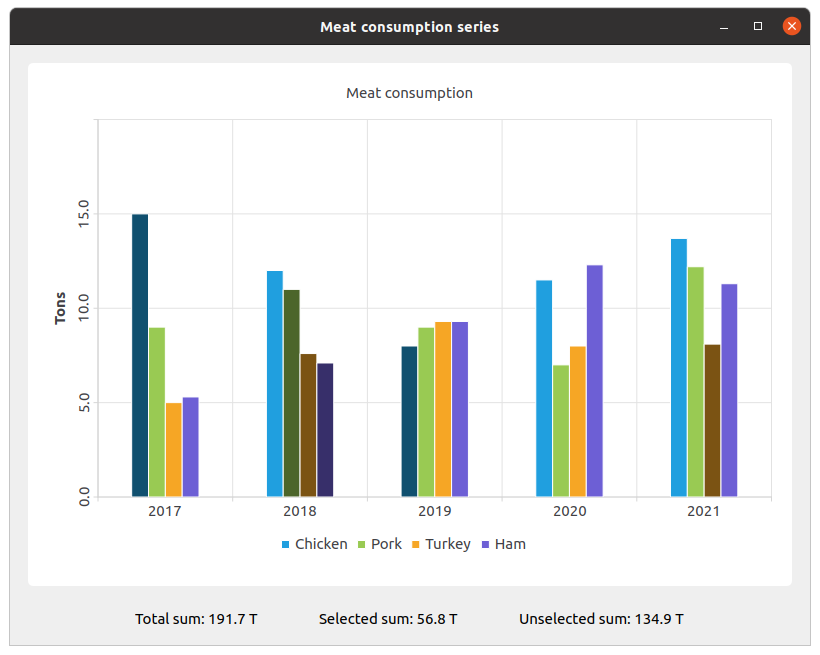The example shows how to use a selection feature for the bar chart.
The example shows changing the color and state of bars using the selection feature.

要运行范例从 Qt Creator ,打开 Welcome 模式,然后选择范例从 Examples 。更多信息,拜访 构建和运行范例 .
We create the sets and fill them with the data. Then we create a series and append data to it.
QBarSet *setChicken = Utilities::createChickenSet(); QBarSet *setPork = Utilities::createPorkSet(); QBarSet *setTurkey = Utilities::createTurkeySet(); QBarSet *setHam = Utilities::createHamSet(); qreal totalSum = setChicken->sum() + setPork->sum() + setTurkey->sum() + setHam->sum(); QList<QBarSet *> setList = QList<QBarSet *>{setChicken, setPork, setTurkey, setHam}; QBarSeries *series = new QBarSeries(); series->append(setList);
We create the chart and add series to it. Also, we add a title to the chart, set animation for the chart, and align the legend.
QChart *chart = new QChart(); chart->addSeries(series); chart->setTitle(QCoreApplication::tr("Meat consumption")); chart->setAnimationOptions(QChart::SeriesAnimations); chart->legend()->setVisible(true); chart->legend()->setAlignment(Qt::AlignBottom);
Here we set the color for the selected bars.
for (QBarSet *barSet : series->barSets()) barSet->setSelectedColor(barSet->brush().color().darker());
Next step is adding axes: QBarCategoryAxis for years of measurements and QValueAxis for values range.
QStringList categories = Utilities::createYearCategories(); QBarCategoryAxis *axisX = new QBarCategoryAxis(); axisX->setCategories(categories); chart->addAxis(axisX, Qt::AlignBottom); series->attachAxis(axisX); QValueAxis *axisY = new QValueAxis(); axisY->setRange(0, 20); axisY->setTitleText(QCoreApplication::tr("Tons")); axisY->setLabelsAngle(-90); axisY->setTitleVisible(true); chart->addAxis(axisY, Qt::AlignLeft); series->attachAxis(axisY);
Then we add the chart view to put the chart in.
QChartView *chartView = new QChartView(chart); chartView->setRenderHint(QPainter::Antialiasing);
Here we create a widget for labels of values of selected and unselected bars.
QWidget *labelWidget = new QWidget(&mainWindow); QHBoxLayout *labelLayout = new QHBoxLayout(labelWidget); labelLayout->setAlignment(Qt::AlignCenter); QLabel *totalSumLabel = new QLabel(QCoreApplication::tr("Total sum: %1 T").arg(totalSum)); labelLayout->addWidget(totalSumLabel); totalSumLabel->setContentsMargins(0, 0, 54, 0); QLabel *selectedSumLabel = new QLabel(QCoreApplication::tr("Selected sum: 0 T")); labelLayout->addWidget(selectedSumLabel); QLabel *unselectedSumLabel = new QLabel(QCoreApplication::tr("Unselected sum: %1 T").arg(totalSum)); labelLayout->addWidget(unselectedSumLabel); unselectedSumLabel->setContentsMargins(54, 0, 0, 0);
We connect selecting of a specific bar with labels of values using a lambda.
set->toggleSelection({index})
sets the bar selected.
QObject::connect(series, &QAbstractBarSeries::clicked, series, [=](int index, QBarSet *set) { set->toggleSelection({index}); qreal selectedSum = 0.; for (int i = 0; i < setList.size(); ++i) { auto selectedIndices = setList.at(i)->selectedBars(); for (int k = 0; k < selectedIndices.size(); ++k) selectedSum += setList.at(i)->at(selectedIndices.at(k)); } selectedSumLabel->setText(QCoreApplication::tr("Selected sum: %1 T").arg(selectedSum)); // Because of rounding errors, selectedSum can result in being bigger than total sum qreal unselectedSum = totalSum - selectedSum < 0 ? 0. : totalSum - selectedSum; unselectedSumLabel->setText( QCoreApplication::tr("Unselected sum: %1 T") .arg(unselectedSum) ); });
Finally, we create the main widget and add other layouts to it and run the application.
QWidget *mainWidget = new QWidget(&mainWindow); QVBoxLayout *mainLayout = new QVBoxLayout(mainWidget); mainLayout->addWidget(chartView); mainLayout->addWidget(labelWidget); mainWindow.setCentralWidget(mainWidget); mainWindow.resize(800, 600); mainWindow.show(); return a.exec();